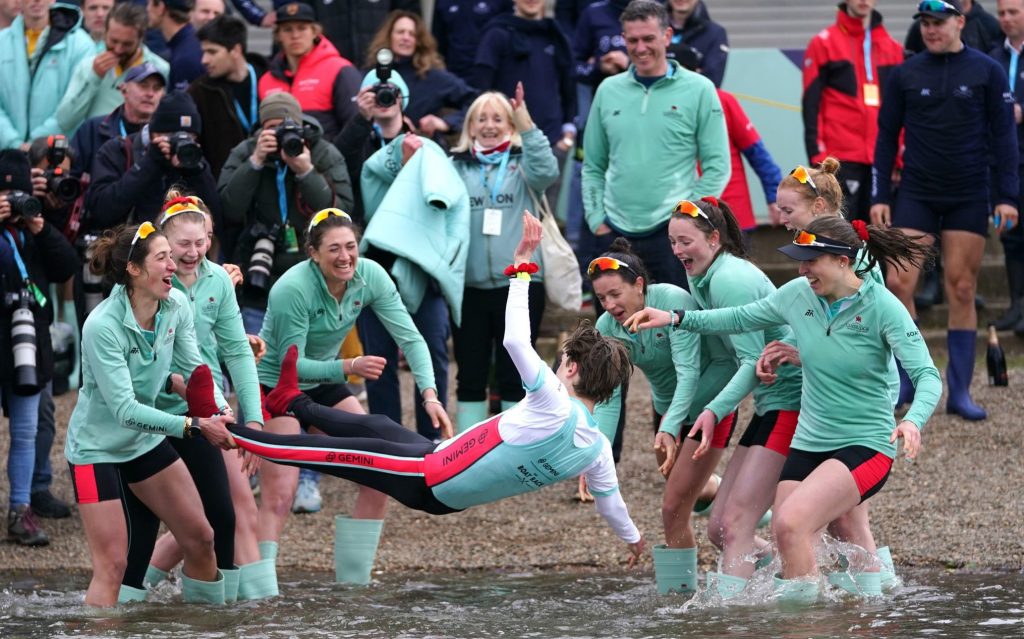
The Boat Race tradition of throwing winning coxes into the Thames will not be blocked by organisers on Sunday after encouraging late water tests.
Dry weather in recent weeks and a new “super sewer” have improved readings from last year, when event officials explicitly advised rowers against diving into the river.
This time, Oxford and Cambridge crews are being privately encouraged to make up their own minds as an inevitable row brews around sickness risks.
Campaign group River Action, which started testing for the E. coli in the Thames on March 10, maintains 29.5 per cent of its results exceeded safe limits.
However, the teams have been sent a dossier of data, including tests by Fulham Reach Boat Club, which show waters have been “excellent” – effectively at bathing quality.
A source close to the event underlined to Telegraph Sport that the “healthy young” crews should be allowed to decide for themselves. The captain of Oxford women’s team is among medics who are likely to help with team deliberations.

E. coli scares dogged teams at the event in March last year, with rowers on the men’s Oxford team complaining of “poo in the water” and saying sickness had played a part in their defeat.
Cleaning up the Thames long term is a major theme for the event this year, with the Boat Race Company having joined the Oxford and Cambridge teams in signing up to the so-called London Rivers’ Pledge.
River Action has expressed scepticism, however, over the campaign, and said “the stretch of the Thames used for the Boat Race… would be graded poor, the lowest possible rating” as a bathing site.

Officially organisers are encouraging rowers to follow British Rowing guidance, which in poor water situations can include advice not to enter the water. “Clearly the water quality testing carried out along the River Thames shows there is more work to be done to get our waterways where we all want them to be,” the Boat Race Company has said.
But with the £5 billion Thames Tideway Tunnel now fully connected, there is optimism behind the scenes that the tradition of throwing coxes in will return. More than six million cubic metres of sewage was prevented from entering the river in recent months.
In response to concerns over water quality, a Thames Water spokesman said: “Rivers are very dynamic environments, and samples can vary hugely within a short period of time. Paradoxically, recent tests on E. coli carried out by Fulham Reach Boat Club have results within the “excellent” threshold since the start of March.”
Last year, heeding the warnings, the winning Cambridge women’s team lifted their cox in the air, rather than throwing her into the water, as is tradition. Sean Bowden, Oxford’s coach at the time, Called the situation a “national disgrace”.

The Boat Race tradition of throwing winning coxes into the Thames will not be blocked by organisers on Sunday after encouraging late water tests.
Dry weather in recent weeks and a new “super sewer” have improved readings from last year, when event officials explicitly advised rowers against diving into the river.
This time, Oxford and Cambridge crews are being privately encouraged to make up their own minds as an inevitable row brews around sickness risks.
Campaign group River Action, which started testing for the E. coli in the Thames on March 10, maintains 29.5 per cent of its results exceeded safe limits.
However, the teams have been sent a dossier of data, including tests by Fulham Reach Boat Club, which show waters have been “excellent” – effectively at bathing quality.
A source close to the event underlined to Telegraph Sport that the “healthy young” crews should be allowed to decide for themselves. The captain of Oxford women’s team is among medics who are likely to help with team deliberations.

E. coli scares dogged teams at the event in March last year, with rowers on the men’s Oxford team complaining of “poo in the water” and saying sickness had played a part in their defeat.
Cleaning up the Thames long term is a major theme for the event this year, with the Boat Race Company having joined the Oxford and Cambridge teams in signing up to the so-called London Rivers’ Pledge.
River Action has expressed scepticism, however, over the campaign, and said “the stretch of the Thames used for the Boat Race… would be graded poor, the lowest possible rating” as a bathing site.

Officially organisers are encouraging rowers to follow British Rowing guidance, which in poor water situations can include advice not to enter the water. “Clearly the water quality testing carried out along the River Thames shows there is more work to be done to get our waterways where we all want them to be,” the Boat Race Company has said.
But with the £5 billion Thames Tideway Tunnel now fully connected, there is optimism behind the scenes that the tradition of throwing coxes in will return. More than six million cubic metres of sewage was prevented from entering the river in recent months.
In response to concerns over water quality, a Thames Water spokesman said: “Rivers are very dynamic environments, and samples can vary hugely within a short period of time. Paradoxically, recent tests on E. coli carried out by Fulham Reach Boat Club have results within the “excellent” threshold since the start of March.”
Last year, heeding the warnings, the winning Cambridge women’s team lifted their cox in the air, rather than throwing her into the water, as is tradition. Sean Bowden, Oxford’s coach at the time, Called the situation a “national disgrace”.












